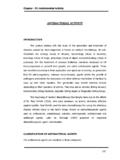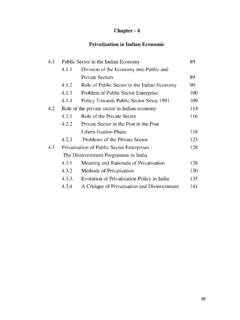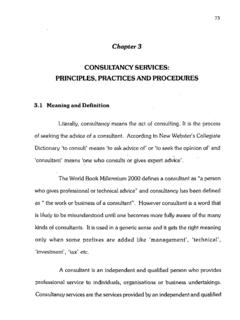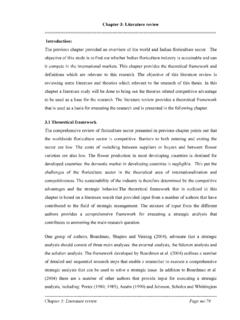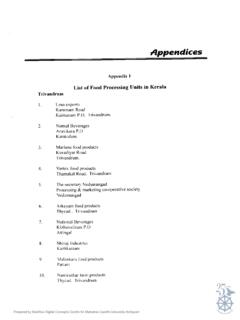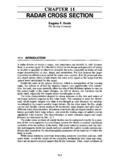Transcription of CHAPTER - 1 INTRODUCTION OF COMPANY PROFILE OF …
1 INTRODUCTION of COMPANY PROFILE of Automobile Industry of India CHAPTER -1 [1] INTRODUCTION AUTOMOBILE INDUSTRY DEVELOPMENT OF AUTOMOBILE INDUSTRY THE WHEEL HORSE POWER STEAM POWERED VEHICLES ELECTRIC VEHICLES INTERNAL COMBUSTION ENGINES INDUSTRY HISTORY THE MODERN INDUSTRY HISTORY OF AUTOMOBILE INDUSTRY IN WORLD HISTORY OF THE JAPANESE AUTOMOBILE INDUSTRY HISTORY OF THE AMERICAN AUTOMOBILE INDUSTRY THE AUTOMOBILE INDUSTRY AT PRESENT SCOPE OF AUTOMOBILE INDUSTRY IN THE NEAR FUTURE HISTORY OF THE INDIAN AUTOMOBILE INDUSTRY PRE-1991, BEFORE LIBERALIZATION POST-1991, AFTER LIBERALIZATION, THE FREEDOM TO GROW THE INDIAN AUTOMOBILE INDUSTRY AT PRESENT DEVELOPMENT OF AUTOMOBILE INDUSTRY IN INDIA GOVERNMENT POLICY OF AUTOMOBILE INDUSTRY DEMAND DRIVERS OF AUTOMOBILE INDUSTRY RECENT NEW TRENDS OF AUTOMOBILE INDUSTRY IN INDIA CHAPTER - 1 introduction OF COMPANY PROFILE OF AUTOMOBILE INDUSTRY OF INDIA INTRODUCTION of COMPANY PROFILE of Automobile Industry of India CHAPTER -1 [2]
2 PROFILE OF SELECTED INDIAN AUTOMOBILE COMPANY HERO MOTOCORP LIMITED TVS MOTORS COMPANY LTD SCOOTER INDIA LTD LML LTD BAJAJ AUTO LTD HINDUSTAN MOTORS LIMITED MARUTI SUZUKI INDIA LTD MAHINDRA & MAHINDRA LIMITED ASHOKLEYAND LIMITED TATA MOTORS LIMITED ACHIEVEMENTS OF THE SELECTED AUTOMOBILE COMPANY HERO MOTOCORP LIMITED TVS MOTORS COMPANY LTD SCOOTER INDIA LTD LML LTD BAJAJ AUTO LTD HINDUSTAN MOTORS LIMITED MARUTI SUZUKI INDIA LTD MAHINDRA & MAHINDRA LIMITED ASHOKLEYAND LIMITED TATA MOTORS LIMITED REFERENCE INTRODUCTION of COMPANY PROFILE of Automobile Industry of India CHAPTER -1 [3] INTRODUCTION : The Indian automotive industry has emerged as a 'sunrise sector' in the Indian economy. India is emerging as one of the world's fastest growing passenger car markets and second largest two wheeler manufacturer. It is also home for the largest motor cycle manufacturer and fifth largest commercial vehicle manufacturer.
3 India is the largest base to export compact cars to Europe. Moreover, hybrid and electronic vehicles are new developments on the automobile canvas and India is one of the key markets for them. Global and Indian manufacturers are focusing their efforts to develop innovative products, technologies and supply chains. AUTOMOBILE INDUSTRY: Automobile industry, the business of producing and selling self-powered vehicles, including passenger cars, trucks, farm equipment, and other commercial vehicles. By allowing consumers to commute long distances for work, shopping, and entertainment, the auto industry has encouraged the development of an extensive road system, made possible the growth of suburbs and shopping centers around major cities, and played a key role in the growth of ancillary industries, such as the oil and travel businesses.
4 The auto industry has become one of the largest purchasers of many key industrial products, such as steel. The large number of people the industry employs has made it a key determinant of economic growth. Automobile is self propelled vehicle which is used for the transportation of passenger and good upon the ground. A vehicle is machine which is used for the transportation of passengers and goods. Car, bus truck, jeep, tractor, scooter, motor cycles are the example of automobiles. CHAPTER - 1 introduction OF COMPANY PROFILE OF AUTOMOBILE INDUSTRY OF INDIA INTRODUCTION of COMPANY PROFILE of Automobile Industry of India CHAPTER -1 [4] DIFFERENT NAMES OF THE AUTOMOBILE: 1. Auto 2. Auto car 3. Car 4. Motor car 5. Automobile 6. Auto buggy 7. Motor coach 8. Motor vehicle 9. Motor 10. Motor wagon 11. Horseless carriage TYPES OF AUTOMOBILES: The automobiles are classified on the following basis:- 1. Purpose : (i) Passenger vehicle- car, jeep, bus (ii) Good Vehicle- Truck 2.
5 Capacity :- (I) Light motor vehicle- car, motor cycle, scooter. (II) Heavy Motor vehicle- Bus coach, tractor. 3. Fuel used:- (i) Petrol vehicles car, jeep, motor cycle, scooter. (ii) Diesel Vehicles- Truck, bus, tractor, bulldozer. (iii) Electric cab- Battery truck, fork lift, scooter (iv) Stream carriage- stream road rollers. 4. No of Wheels :- (i) Two Wheeler (ii) Three Wheeler (iii) Four Wheeler (iv) Six Wheeler. 5. Drive of the vehicles :- (i) Singles wheel drive vehicle (ii) Two wheel drive vehicle (iii) Four wheel drive vehicle (iv) Six wheel drive vehicle INTRODUCTION of COMPANY PROFILE of Automobile Industry of India CHAPTER -1 [5] DEVELOPMENT OF AUTOMOBILE INDUSTRY: CHART NO. DEVELOPMENT OF AUTOMOBILE INDUSTRY THE WHEEL: The invention of the wheel paved the way for transportation as we know it today. Historians don t know exactly who invented the wheel, but the oldest wheel discovered so far is believed to be over 5,500 years old.
6 The development of the wheel began when humans sought easier methods for moving large objects. It was recognized that round objects, such as a log, could be placed under something heavy to push it along with less force. Next humans began using a sledge. A sledge is essentially what today we would call a sled. A sledge worked well over smooth ground or with logs placed under it as it was pulled along. Eventually the sledge wore grooves in the log rollers. The grooved rollers worked better since there was less friction between the sledge and the rollers, so less energy was needed to drag the sledge. It wasn t long before humans cut away the wood between the two inner grooves created by the sledge. The wood left between the grooves became the axle. These were the first carts. Next, axles were designed to fit through holes in the center of each wheel. INTRODUCTION of COMPANY PROFILE of Automobile Industry of India CHAPTER -1 [6] Finally, axles were designed not to move themselves, but rather to have the wheel rotate on the axle.
7 The ancient Egyptians, Indians, Greeks and Romans continued to improve the design of the wheel, adding spokes and creating a variety of wheels for different sorts of vehicles including chariots for war, hunting, and racing, two-wheeled farm carts, covered carriages, heavy four-wheeled freight wagons and passenger coaches. HORSE POWER: For centuries wheeled vehicles were pulled by oxen, horses or even people. Until the invention of the internal combustion engine, the horse was Europe's most important source of energy. The term 'horsepower' is still used today to measure the power limits of machine engines. Horses allowed civilizations to extend their power and expand their territories. When paired with wheeled vehicles such as carts, chariots and carriages, this harnessed power allowed people more freedom to travel, explore and settle new land. However, even horse drawn transportation came with its own source of pollution.
8 Waste from horses was a serious concern in cities and it became more and more difficult to maintain sanitary conditions as the number of people and, therefore, horses grew. Concerns over these conditions led some innovators to look towards alternative forms of transportation. STEAM POWERED VEHICLES: In the 17th century, steam-powered vehicles, dubbed horseless carriages, came on to the scene. However, it was not until the early 18th century and the invention of the high pressure steam engine that these steam-powered vehicles were considered as potentially practical. Limitations in building technology and the poor condition of road surfaces limited these steam cars as personal transportation until the19th century. At first, their sheer heaviness meant that they needed the support of iron rails to move effectively. This of course led to the use of steam engines in trains, thus powering the railroad industry.
9 By 1902, 485 out of 909 new car registrations were for steamers. In 1906, the land speed record was broken by a Stanley steam car. The car and driver reached 127 miles per hour! The steam engine powered the vehicle by burning wood, coal or oil to heat water in a boiler. The steam that was generated drove pistons up and down within hollow cylinders. The movement of the pistons drove the crankshaft, which INTRODUCTION of COMPANY PROFILE of Automobile Industry of India CHAPTER -1 [7] ultimately turned the wheels. In addition to their considerable weight, steam powered vehicles had several other disadvantages. They required long start-up times and required frequent stops to get water. ELECTRIC VEHICLES: In the 1830s, inventors also began to use electric motors to power vehicles. Like electric cars today, they ran on energy stored in rechargeable batteries. Unfortunately, the energy storage capacity of the early batteries was very limited, and these vehicles could travel relatively short distances before the batteries needed to be recharged.
10 Although the range of early electric vehicles was limited, they could travel further on a single charge than steam-powered vehicles could go without stopping to renew their water supply. Initially, the electric car s limited range was not a liability because the only good roads at the time were in towns. The electric car also had several advantages over other types of vehicles until the early 1900 s. Driving electric cars, like steam-powered vehicles, did not require changing gears, which was a difficult maneuver in driving early gasoline-powered cars. In comparison to cars with gas engines, electric vehicles were also quieter, offered a smoother ride, and were relatively odor-free. They also did not require a long start-up time like the steam car or the considerable manual effort that was required to start a gas-powered car with a hand crank. In 1899 and 1900, the sale of electric cars surpassed those of all other types of vehicles in the However, the prominence of the electric car was destined to be short-lived as several developments shifted the advantage to gasoline powered vehicles.
